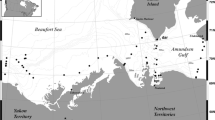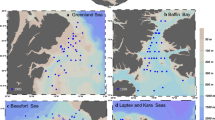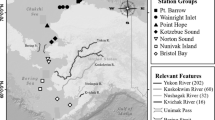Abstract
Capelin (Mallotus villosus), a sub-Arctic forage fish, has become abundant in the Canadian Arctic in recent decades, with consistent spawning documented; however, the trophic role of capelin in these systems is unknown. We investigated the diets of small, immature (70–129 mm), medium, mature (130–174 mm), and large, mature (175–219 mm) capelin in Pangnirtung Fjord, Nunavut during and prior to spawning in June–July, 2015–2016 using stomach contents and stable isotopes, respectively. Ontogenetic niche shifts were observed in both cases. Small, immature capelin consumed predominantly small copepods (primarily Clausocalanidae) and had a narrow isotopic niche (SEAC: 0.11 ‰2). In contrast, medium-sized, mature capelin consumed a mix of Calanus copepods, amphipods, and mysids and had a broad isotopic niche (SEAC range: 0.23–0.51 ‰2), while large, mature capelin consumed higher proportions of large prey types (primarily Calanus hyperboreus and amphipods) and had a narrower isotopic niche (SEAC range: 0.09–0.26 ‰2). A higher percentage (by dry biomass) of capelin eggs (73–100%) were consumed by mature capelin in 2016, when ice cover in the fjord delayed the initiation of sampling by ~ 10 days after spawning had begun, relative to 2015 (0–9%). Non-egg prey types primarily consisted of amphipods (77–100% by dry biomass, mostly ice-associated Apherusa glacialis) in 2016 and primarily pelagic Calanus copepods (64–99%) in 2015. As capelin diet was broadly similar to other Arctic forage fishes, such as polar cod (Boreogadus saida), high dietary overlap may occur. Findings provide baseline data to examine future changes in capelin diet as well as their trophic interactions in the Canadian Arctic.



Similar content being viewed by others
References
Alley TR (1982) Competition theory, evolution, and the concept of an ecological niche. Acta Biotheor 31:165–179. https://doi.org/10.1007/BF01857239
Bogetveit FR, Slotte A, Johannessen A (2008) The ability of gadoids to take advantage of a short-term high availability of forage fish: the example of spawning aggregations in Barents Sea capelin. J Fish Biol 72:1427–1449. https://doi.org/10.1111/j.1095-8649.2008.01808.x
Bone B, Davoren GK (2018) Egg cannibalism in capelin Mallotus villosus at beach and deep-water spawning habitats in the north-west Atlantic Ocean. J Fish Biol 93:641–648. https://doi.org/10.1111/jfb.13740
Burton MPM, Flynn SR (1998) Differential postspawning mortality among male and female capelin (Mallotus villosus Müller) in captivity. Can J Zool 76:588–592. https://doi.org/10.1139/z97-205
Carscadden JE, Gjøsæter H, Vilhjálmsson H (2013) A comparison of recent changes in distribution of capelin (Mallotus villosus) in the Barents Sea, around Iceland and in the Northwest Atlantic. Prog Oceanogr 114:64–83. https://doi.org/10.1016/j.pocean.2013.05.005
Carscadden JE, Montevecchi WA, Davoren GK, Nakashima BS (2002) Trophic relationships among capelin (Mallotus villosus) and seabirds in a changing ecosystem. ICES J Mar Sci 59:1027–1033. https://doi.org/10.1006/jmsc.2002.1235
Charnov EL (1976) Optimal foraging, the marginal value theorem. Theor Popul Biol 9:129–136. https://doi.org/10.1016/0040-5809(76)90040-X
Christiansen JS, Præbel K, Siikavuopio SI, Carscadden JE (2008) Facultative semelparity in capelin Mallotus villosus (Osmeridae)-an experimental test of a life history phenomenon in a sub-arctic fish. J Exp Mar Bio Ecol 360:47–55. https://doi.org/10.1016/j.jembe.2008.04.003
Dalpadado P, Mowbray F (2013) Comparative analysis of feeding ecology of capelin from two shelf ecosystems, off Newfoundland and in the Barents Sea. Prog Oceanogr 114:97–105. https://doi.org/10.1016/j.pocean.2013.05.007
Davoren GK (2013) Divergent use of spawning habitat by male capelin (Mallotus villosus) in a warm and cold year. Behav Ecol 24:152–161. https://doi.org/10.1093/beheco/ars147
Davoren GK, Anderson JT, Montevecchi WA (2006) Shoal behaviour and maturity relations of spawning capelin (Mallotus villosus) off Newfoundland: demersal spawning and diel vertical movement patterns. Can J Fish Aquat Sci 63:268–284. https://doi.org/10.1139/f05-204
Eriksen E, Skjoldal HR, Dolgov AV et al (2016) The Barents Sea euphausiids: methodological aspects of monitoring and estimation of abundance and biomass. ICES J Mar Sci 73:1533–1544. https://doi.org/10.1093/icesjms/fsw022
Flynn SR, Nakashima BS, Burton MPM (2001) Direct assessment of post-spawning survival of female capelin, Mallotus villosus. J Mar Biol Assoc UK 81:307–312. https://doi.org/10.1017/S0025315401003782
Fortune SME, Ferguson SH, Trites AW et al (2020) Seasonal diving and foraging behaviour of Eastern Canada-West Greenland bowhead whales. Mar Ecol Prog Ser 643:197–217. https://doi.org/10.3354/meps13356
Frank KT, Carscadden JE, Simon JE (1996) Recent excursions of capelin (Mallotus villosus) to the Scotian Shelf and Flemish Cap during anomalous hydrographic conditions. Can J Fish Aquat Sci 53:1473–1486. https://doi.org/10.1139/cjfas-53-7-1473
Friðgeirsson E (1976) Observations on spawning behaviour and embryonic development of the Icelandic capelin. Rit Fiskid 5:1–35
Gaston AJ, Woo K, Hipfner JM (2003) Trends in forage fish populations in Northern Hudson Bay since 1981, as determined from the diet of nestling thick-billed murres Uria lomvia. Arctic 56:227–233
Gjøsæter H (1998) The population biology and exploitation of capelin (Mallotus villosus) in the Barents Sea. Sarsia 83:453–496. https://doi.org/10.1080/00364827.1998.10420445
Gjøsæter H, Dalpadado P, Hassel A (2002) Growth of Barents Sea capelin (Mallotus villosus) in relation to zooplankton abundance. ICES J Mar Sci 59:959–967. https://doi.org/10.1006/jmsc.2002.1240
Grønkjær P, Nielsen KV, Zoccarato G et al (2019) Feeding ecology of capelin (Mallotus villosus) in a fjord impacted by glacial meltwater (Godthåbsfjord, Greenland). Polar Biol 42:81–98. https://doi.org/10.1007/s00300-018-2400-8
Gulka J, Carvalho PC, Jenkins E et al (2017) Dietary niche shifts of multiple marine predators under varying prey availability on the northeast Newfoundland coast. Front Mar Sci 4:1–11. https://doi.org/10.3389/fmars.2017.00324
Hardin G (1960) The competitive exclusion principle. Am Assoc Adv Sci 131:1292–1297
Hassel A, Skjoldal HR, Gjøsæter H et al (1991) Impact of grazing from capelin (Mallotus villosus) on zooplankton: a case study in the northern Barents Sea in August 1985. Polar Res 10:371–388
Hedeholm R, Grønkjær P, Rysgaard S (2012) Feeding ecology of capelin (Mallotus villosus Müller) in West Greenland waters. Polar Biol 35:1533–1543. https://doi.org/10.1007/s00300-012-1193-4
Henderson RJ, Sargent JR, Hopkins CCE (1984) Changes in the content and fatty acid composition of lipid in an isolated population of the capelin Mallotus villosus during sexual maturation and spawning. Mar Biol 78:255–263
Hirche H-J (1997) Life cycle of the copepod Calanus hyperboreus in the Greenland Sea. Mar Biol 128:607–618
Hop H, Gjøsæter H (2013) Polar cod (Boreogadus saida) and capelin (Mallotus villosus) as key species in marine food webs of the Arctic and the Barents Sea. Mar Biol Res 9:878–894. https://doi.org/10.1080/17451000.2013.775458
Huse G (1998) Sex-specific life history strategies in capelin (Mallotus villosus)? Can J Fish Aquat Sci 55:631–638. https://doi.org/10.1139/f97-275
Huse G, Ellingsen I (2008) Capelin migrations and climate change: a modelling analysis. Clim Change 87:177–197. https://doi.org/10.1007/s10584-007-9347-z
Huse G, Toresen R (1996) A comparative study of the feeding habits of herring (Clupea harengus, Clupeidae, L.) and capelin (Mallotus villosus, Osmeridae, MULLER) in the Barents Sea. Sarsia 81:143–153. https://doi.org/10.1177/1463499605061667
Ingram T, Matthews B, Harrod C et al (2007) Lipid extraction has little effect on the δ15N of aquatic consumers. Limnol Oceanogr Methods 5:338–343. https://doi.org/10.4319/lom.2007.5.338
IPCC (2014) Climate Change 2014: synthesis report. Contribution of Working Groups I, II and III to the fifth assessment report of the intergovernmental panel on climate change
Jackson AL, Inger R, Parnell AC, Bearhop S (2011) Comparing isotopic niche widths among and within communities: SIBER - Stable Isotope Bayesian Ellipses in R. J Anim Ecol 80:595–602. https://doi.org/10.1111/j.1365-2656.2011.01806.x
Kosobokova KN (1999) The reproductive cycle and life history of the Arctic copepod Calanus glacialis in the White Sea. Polar Biol 22:254–263
Kwasniewski S, Hop H, Falk-Petersen S, Pedersen G (2003) Distribution of Calanus species in Kongsfjorden, a glacial fjord in Svalbard. J Plankton Res 25:1–20
Marcoux M, McMeans BC, Fisk AT, Ferguson SH (2012) Composition and temporal variation in the diet of beluga whales, derived from stable isotopes. Mar Ecol Prog Ser 471:283–291. https://doi.org/10.3354/meps10029
Maxner E, Halden NM, Roth JD, Davoren GK (2016) Intrinsic factors influence the timing of arrival of capelin (Mallotus villosus) to spawning grounds in coastal Newfoundland. Fish Res 179:202–212. https://doi.org/10.1016/j.fishres.2016.03.002
McNicholl DG, Davoren GK, Reist JD (2018) Life history variation across latitudes: observations between capelin (Mallotus villosus) from Newfoundland and the eastern Canadian Arctic. Polar Biol 41:643–651. https://doi.org/10.1007/s00300-017-2225-x
McNicholl DG, Walkusz W, Davoren GK et al (2016) Dietary characteristics of co-occurring polar cod (Boreogadus saida) and capelin (Mallotus villosus) in the Canadian Arctic, Darnley Bay. Polar Biol 39:1099–1108. https://doi.org/10.1007/s00300-015-1834-5
McNicholl DG, Wolki B, Ostertag S (2017) Traditional ecological knowledge and local observations of capelin (Mallotus villosus) in Darnley Bay, NT. Can Manuscr Rep Fish Aquat Sci 3144:vi + 20 p
Moore SE, Huntington HP (2008) Arctic marine mammals and climate change: impacts and resilience. Ecol Appl 18:s157–165. https://doi.org/10.1890/06-0571.1
O’Driscoll RL, Parsons MJD, Rose GA (2001) Feeding of capelin (Mallotus villosus) in Newfoundland waters. Sarsia 86:165–176. https://doi.org/10.1080/00364827.2001.10420472
Obradovich SG, Carruthers EH, Rose GA (2014) Bottom-up limits to Newfoundland capelin (Mallotus villosus) rebuilding: the euphausiid hypothesis. ICES J Mar Sci 71:775–783
Ogloff WR, Yurkowski DJ, Davoren GK, Ferguson SH (2019) Diet and isotopic niche overlap elucidate competition potential between seasonally sympatric phocids in the Canadian Arctic. Mar Biol 166:103. https://doi.org/10.1007/s00227-019-3549-6
Orlova EL, Dolgov AV, Renaud PE et al (2015) Climatic and ecological drivers of euphausiid community structure vary spatially in the Barents Sea: relationships from a long time series (1952–2009). Front Mar Sci 1:1–13. https://doi.org/10.3389/fmars.2014.00074
Orlova EL, Dolgov AV, Rudneva GB et al (2009) Trophic relations of capelin Mallotus villosus and polar cod Boreogadus saida in the Barents Sea as a factor of impact on the ecosystem. Deep Res Part II Top Stud Oceanogr 56:2054–2067. https://doi.org/10.1016/j.dsr2.2008.11.016
Ozhigin VK, Luka GI (1985) Some peculiarities of capelin migrations depending on the thermal conditions in the Barents Sea. In: Gjøsæter H (ed) The proceedings of the Soviet-Norwegian symposium on the Barents Sea capelin. Institute of Marine Research, Bergen, pp 135–148
Ozhigin VK, Ushakov NG (1985) The effect of the thermal conditions of the sea and atmospheric circulation on the distribution of the Barents Sea capelin feeding areas. In: Gjøsæter H (ed) The proceedings of the Soviet-Norwegian symposium on the Barents Sea capelin. Institute of Marine Research, Bergen, pp 149–156
Poltermann M (2000) Growth, production and productivity of the Arctic sympagic amphipod Gammarus wilkitzkii. Mar Ecol Prog Ser 193:109–116. https://doi.org/10.3354/meps193109
Ressler PH, Dalpadado P, Macaulay GJ et al (2015) Acoustic surveys of euphausiids and models of baleen whale distribution in the Barents Sea. Mar Ecol Prog Ser 527:13–29. https://doi.org/10.3354/meps11257
Ricca MA, Miles AK, Anthony RG et al (2007) Effect of lipid extraction on analyses of stable carbon and stable nitrogen isotopes in coastal organisms of the Aleutian archipelago. Can J Zool 85:40–48. https://doi.org/10.1139/z06-187
Rose GA (2005) Capelin (Mallotus villosus) distribution and climate: a sea “canary” for marine ecosystem change. ICES J Mar Sci 62:1524–1530. https://doi.org/10.1016/j.icesjms.2005.05.008
Schmitt RJ, Holbrook SJ (1984) Gape-limitation, foraging tactics and prey size selectivity of two microcarnivorous species of fish. Oecologia 63:6–12. https://doi.org/10.1007/BF00379778
Shackell NL, Shelton PA, Hoenig JM, Carscadden JE (1994) Age- and sex-specific survival of northern Grank Bank capelin (Mallotus villosus). Can J Fish Aquat Sci 51:642–649
Slotte A, Mikkelsen N, Gjøsæter H (2006) Egg cannibalism in Barents Sea capelin in relation to a narrow spawning distribution. J Fish Biol 69:187–202. https://doi.org/10.1111/j.1095-8649.2006.01085.x
Solomon CT, Carpenter SR, Rusak JA, Vander Zanden MJ (2008) Long-term variation in isotopic baselines and implications for estimating consumer trophic niches. Can J Fish Aquat Sci 65:2191–2200. https://doi.org/10.1139/F08-125
Stroeve JC, Markus T, Boisvert L et al (2014) Changes in Arctic melt season and implications for sea ice loss. Geophys Res Lett 41:1216–1225. https://doi.org/10.1002/2013GL058951
Tallman RF, Gee JH (1982) Intraspecific resource partitioning in a headwaters stream fish, the pearl dace Semotilus margarita (Cyprinidae). Environ Biol Fishes 7:243–249. https://doi.org/10.1007/BF00002499
Templeman W (1948) The life history of the caplin (Mallotus villosus O. F. Müller) in Newfoundland waters. Bull Newfoundl Gov Lab 17:1–151
Ulrich KL (2013) Trophic ecology of Arctic char (Salvelinus alpinus L.) in the Cumberland Sound region of the Canadian Arctic. Master’s Thesis, Department of Biological Sciences, University of Manitoba, Winnipeg, Canada
Vander Zanden MJ, Clayton MK, Moody EK et al (2015) Stable isotope turnover and half-life in animal tissues: a literature synthesis. PLoS ONE 10:e0116182. https://doi.org/10.1371/journal.pone.0116182
Vilhjálmsson H (2002) Capelin biology and ecology: Capelin (Mallotus villosus) in the Iceland-East Greenland–Jan Mayen ecosystem. ICES J Mar Sci 59:870–883
Walkusz W, Majewski A, Reist JD (2013) Distribution and diet of the bottom dwelling Arctic cod in the Canadian Beaufort Sea. J Mar Syst 127:65–75. https://doi.org/10.1016/j.jmarsys.2012.04.004
Watt CA, Orr J, Ferguson SH (2016) A shift in foraging behaviour of beluga whales Delphinapterus leucas from the threatened Cumberland Sound population may reflect a changing Arctic food web. Endanger Sp Res 31:259–270. https://doi.org/10.3354/esr00768
Werner EE, Gilliam JF (1984) The ontogenetic niche and species interactions in size-structured populations. Annu Rev Ecol Syst 15:393–425
Wilson MT, Jump CM, Duffy-Anderson JT (2006) Comparative analysis of the feeding ecology of two pelagic forage fishes: Capelin Mallotus villosus and walleye pollock Theragra chalcogramma. Mar Ecol Prog Ser 317:245–258. https://doi.org/10.3354/meps317245
Winters GH (1970) Biological changes in coastal capelin from the over-wintering to the spawning condition. J Fish Res Board Canada 27:2215–2224. https://doi.org/10.1139/f70-250
Winters GH (1982) Life history and geographical patterns of growth in capelin, Mallotus villosus, of the Labrador and Newfoundland areas. J Northw Atl Fish Sci 3:105–114. https://doi.org/10.2960/j.v3.a9
Yurkowski DJ, Ferguson SH, Semeniuk CAD et al (2016) Spatial and temporal variation of an ice-adapted predator’s feeding ecology in a changing Arctic marine ecosystem. Oecologia 180:631–644. https://doi.org/10.1007/s00442-015-3384-5
Yurkowski DJ, Hussey NE, Fisk AT et al (2017) Temporal shifts in intraguild predation pressure between beluga whales and Greenland halibut in a changing Arctic. Biol Lett 13:20170433. https://doi.org/10.1098/rsbl.2017.0433
Yurkowski DJ, Hussey NE, Semeniuk C et al (2015) Effects of lipid extraction and the utility of lipid normalization models on δ13C and δ15N values in Arctic marine mammal tissues. Polar Biol 38:131–143. https://doi.org/10.1007/s00300-014-1571-1
Acknowledgements
The authors would like to thank the Hunters and Trappers Organization in Pangnirtung, Steven Maniapik for the use of his boat and assistance with capelin sampling, and community members for their advice and help with sampling. Thanks also to Wojciech Walkusz for assistance with capelin prey identification. We gratefully acknowledge Justine Hudson, Tera Edkins, and Mikala Epp for help in the lab, and Gabrielle Grenier and Kevin Crook for help with capelin collection. We thank Bruno Rosenburg for stable isotope analysis at the Freshwater Institute (Winnipeg, MB). We also thank Frances Mowbray and two anonymous reviewers for their constructive feedback. Funding for this research was provided by ArcticNet, Fisheries and Oceans Canada, and the Natural Sciences and Engineering Research Council Discovery Grants (GKD and SHF).
Author information
Authors and Affiliations
Corresponding author
Ethics declarations
Conflict of interest
The authors declare no conflicts of interest.
Additional information
Publisher's Note
Springer Nature remains neutral with regard to jurisdictional claims in published maps and institutional affiliations.
Electronic supplementary material
Below is the link to the electronic supplementary material.
Rights and permissions
About this article
Cite this article
Ogloff, W.R., Ferguson, S.H., Tallman, R.F. et al. Diet of capelin (Mallotus villosus) in the Eastern Canadian Arctic inferred from stomach contents and stable isotopes. Polar Biol 43, 1273–1285 (2020). https://doi.org/10.1007/s00300-020-02707-1
Received:
Revised:
Accepted:
Published:
Issue Date:
DOI: https://doi.org/10.1007/s00300-020-02707-1




